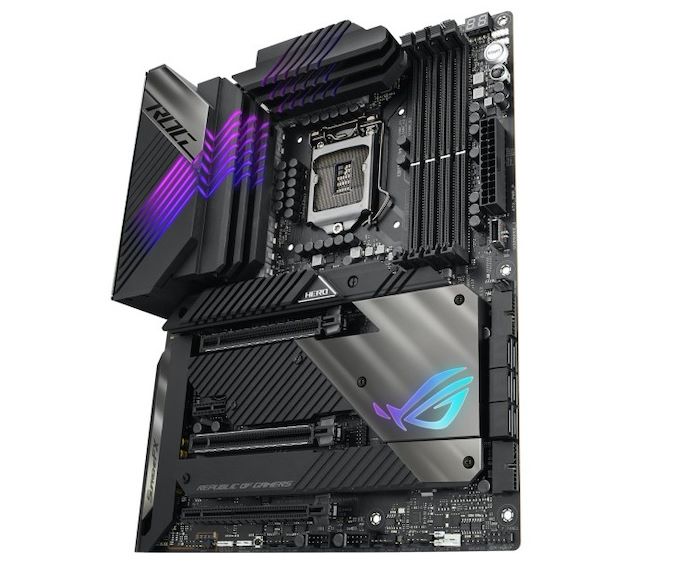ASUS ROG Maximus XIII Hero Review: Everything for Rocket Lake
by Gavin Bonshor on July 9, 2021 9:00 AM EST_678x452.jpg)
On our test bench today is one of ASUS ROG's enthusiast models designed for Intel's Rocket Lake processors. The ASUS ROG Maximus XIII Hero brings plenty of premium controllers and connectivity to the table including dual 2.5 GbE, dual Thunderbolt 4 Type-C, Wi-Fi 6E, four M.2 slots, and a robust 14-phase power delivery capable of pushing Rocket Lake above its capabilities. We have put the Z590 Hero through its paces to see if it is the champion model in the sub $500 Z590 market.
ASUS ROG Maximus XIII Hero Overview
It is probably the last desktop processor on Intel's 14nm architecture, but Rocket Lake comes a bunch of refinements including PCIe 4.0 connectivity through the CPU, support for native USB 3.2 G2x2 on the chipset, and double bandwidth to that chipset enabling deeper IO connectivity. But if every adventure needs a Hero, and ASUS believes it has the one motherboard to rule them all.
Looking at the design, the ASUS ROG Maximus XIII Hero is using a typical ROG premium theme, with predominately black heatsinks, with some areas laden with shiny gun-metal grey. The Hero has two primary zones with integrated RGB LEDs, including the rear panel cover, and the chipset heatsink. Aiming for users looking for a premium experience, ASUS includes a solid all-round selection of features, including four M.2 ports, with one PCIe 4.0 x4, one PCIe 3.0 x4, two with PCIe 3.0 x/4 SATA support, as well as six SATA ports with RAID 0, 1, 5, and 10 array support.
The Hero's expansion capability is geared for PCIe 4.0 connectivity, with two full-length PCIe 4.0 slots operating at x16, and x8/x8 when both full-length slots are populated. There are two other PCIe slots, albeit both at PCIe 3.0 due to being driven by the chipset, which includes one full-length slot operating at x4, and a small x1 slot. Memory support is another premium element that consists of supported speeds of DDR4-5333, with a combined total of 128 GB supported across four memory slots.
In line with other premium Z590 options, the Maximus XIII Hero includes an Intel Maple Ridge Thunderbolt 4 controller, which adds 40 Gbps Type-C ports on the rear panel. The board does benefit from one USB 3.2 G2x2 port, but this comes via the way of a front panel header. ASUS looks to be using as many of Intel's Z590 chipset features as it can, which is good to see. When it comes to onboard audio, ASUS includes a premium HD audio codec with a separate DAC. Other notable mentions include a stacked USB 3.2 G2 array on the rear panel, with a total of six for users to connect up USB devices with. ASUS also includes a solid networking array, with two Intel 2.5 GbE controllers and also utilizes Intel's latest Wi-Fi 6E CNVi.
Focusing on performance, the ASUS ROG Maximus XIII Hero did well in our system tests, with solid and efficient power consumption figures, middle-of-the-road POST times, and exceptional DPC latency performance. In our compute and gaming tests, the Hero remained competitive.

The ASUS ROG Maximus XIII Hero undergoing our VRM thermal testing
When it comes to overclocking, the Maximus XIII Hero performed very well with our i9-11900K and showed exceptionally tight VDroop performance at default loadline calibration and power settings. We managed to get 5.3 GHz stable all-cores at 1.45 V, although we did experience some thermal throttling. With more aggressive cooling methods employed, the Hero is more than capable of pushing Rocket Lake clock speeds. Power consumption when overclocked was also bearable, which is down to the quality of the power delivery, with ASUS using premium Texas Instruments 90 A Smart Power Stages. Our VRM thermal testing also yielded very positive results with the coolest operating temperatures from all Z590 boards tested so far.
The ASUS ROG Maximus XIII Hero has an MSRP of $500, but users shopping around are likely to find it between $470 and $500. Comparing it to the competition on specifications, the primary competition comes from the MSI MEG Z590 Ace ($500) which we have also reviewed. On paper, both look nearly identical, but the Hero benefits from an additional 2.5 GbE port, and more USB 3.2 G2 connectivity on the rear panel. Another benefit that the Hero has comes in the software bundle and the firmware, which are exceptional, and when the hardware is backed up with adequate firmware/software, it makes for a more attractive all-around bundle.
Time to see how the Hero stacks up against other Z590 models! Read on for our extended analysis.











28 Comments
View All Comments
Oxford Guy - Sunday, July 11, 2021 - link
14nm.Oxford Guy - Sunday, July 11, 2021 - link
Everything for Rocket Lake except the relevance.DarkSpatter - Sunday, July 11, 2021 - link
How can you have a 16 phase VRM running in 7.1? I think you mean the board has 16 smart power stages & inductors, with two of each assigned to 7.1 phases?Dr_b_ - Tuesday, July 13, 2021 - link
Had this board, one month in, it died and wouldn't boot. Could be the CPU, but only have one, so RMAd it.